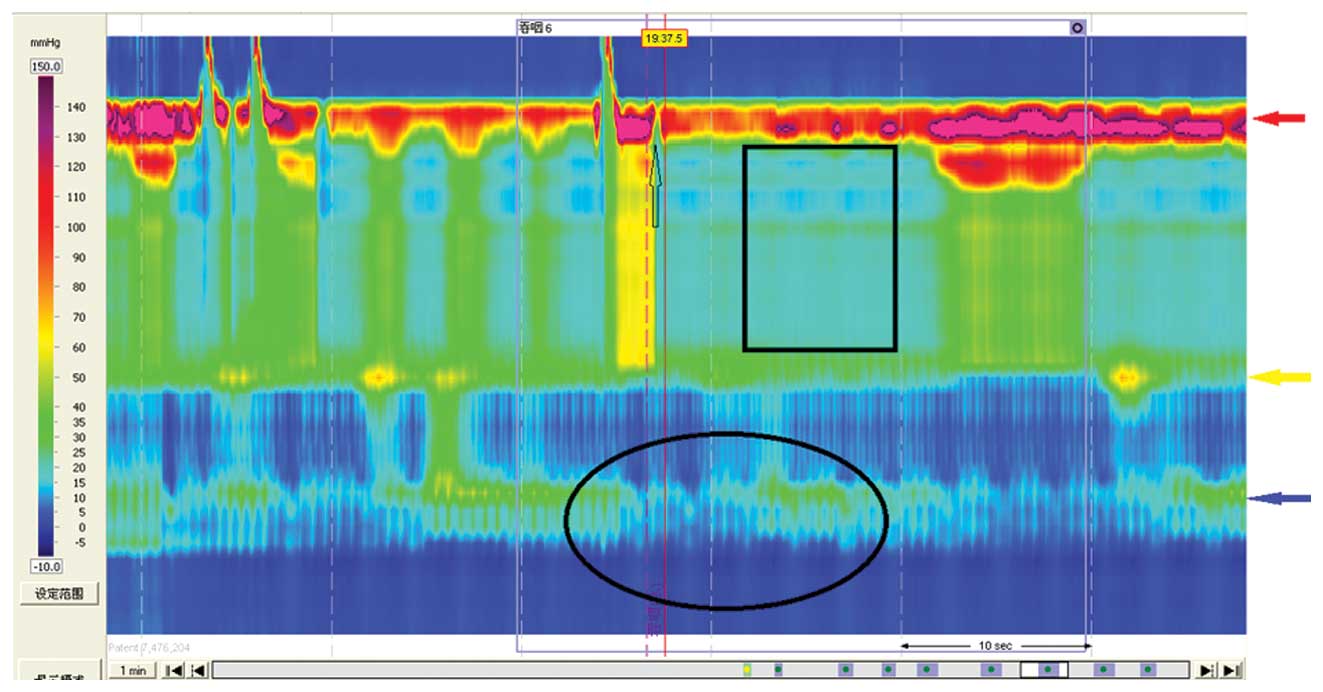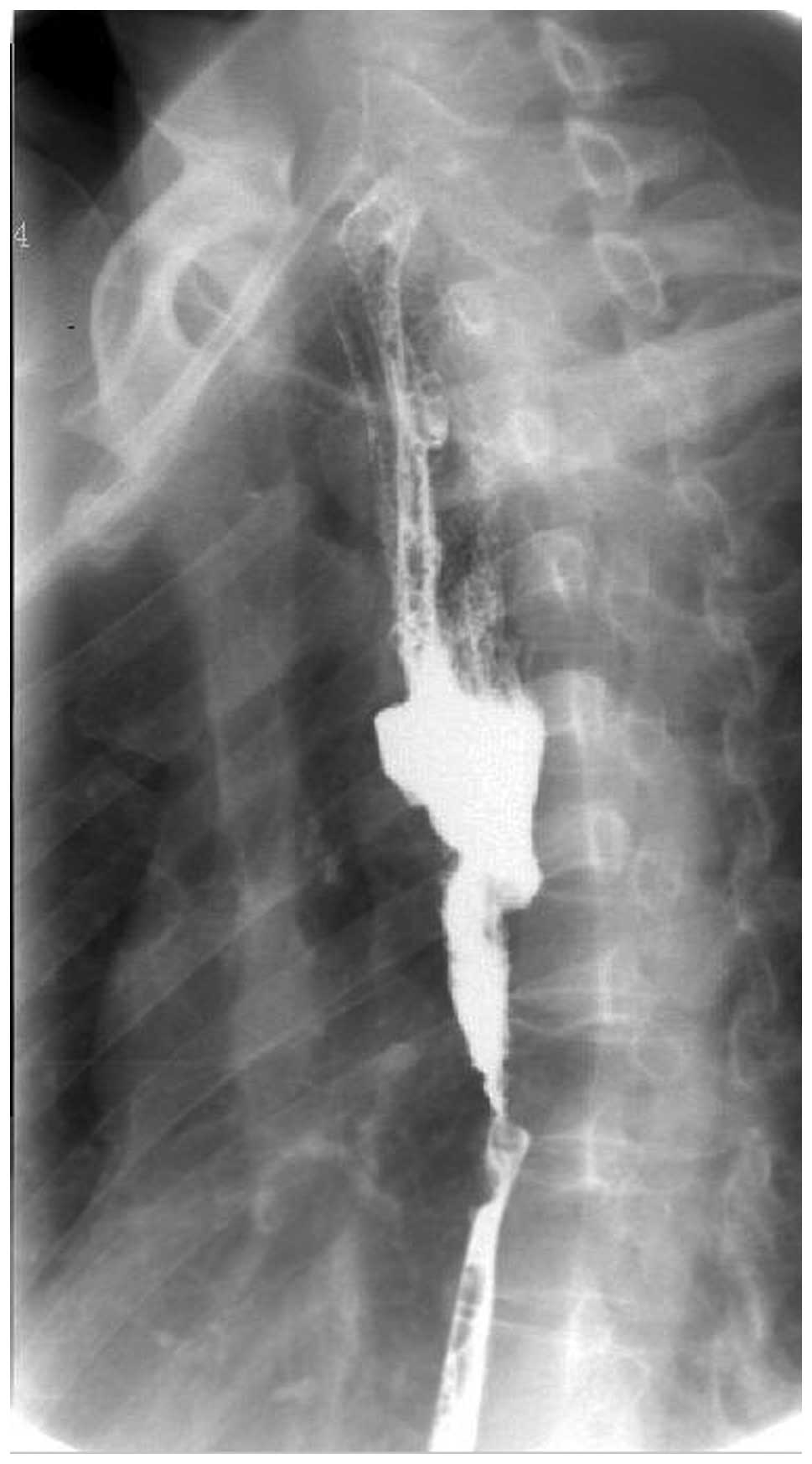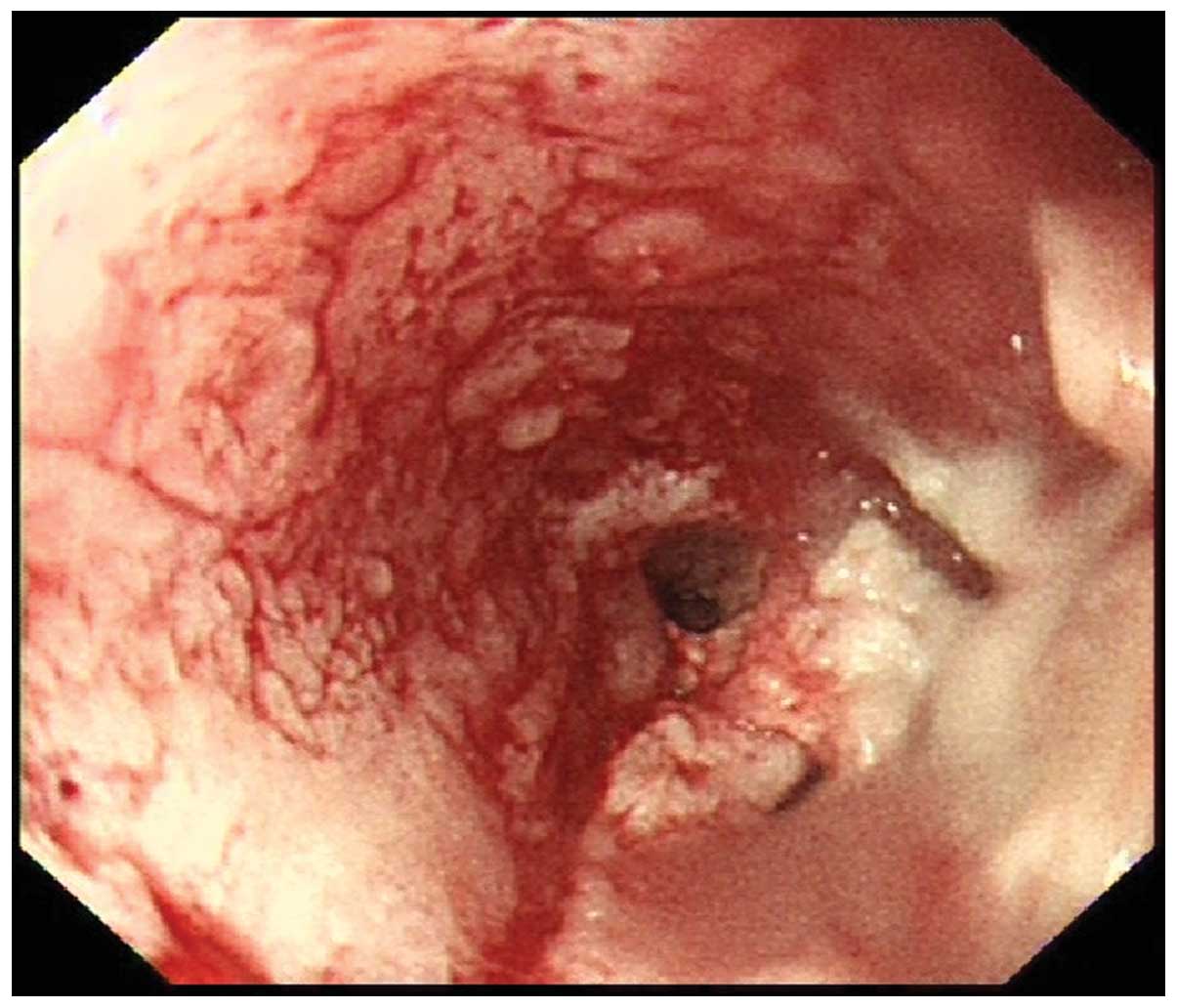Esophageal cancer diagnosed by high-resolution manometry of the esophagus: A case report
- Authors:
- Rongbei Liu
- Hua Chu
- Fei Xu
- Shujie Chen
View Affiliations
Affiliations: Department of Gastroenterology, Sir Run Run Shaw Hospital, School of Medicine, Zhejiang University, Hangzhou, Zhejiang 310000, P.R. China
- Published online on: March 16, 2016 https://doi.org/10.3892/ol.2016.4332
-
Pages:
3131-3134
Metrics: Total
Views: 0 (Spandidos Publications: | PMC Statistics: )
Metrics: Total PDF Downloads: 0 (Spandidos Publications: | PMC Statistics: )
This article is mentioned in:
Abstract
A 48-year-old female who presented with a history of dysphagia for 5 months and regurgitation for 1 week was referred to the Sir Run Run Shaw Hospital (Hangzhou, China) for further evaluation, since the gastroscopy and endoscopic ultrasound performed in local hospitals did not reveal the presence of cancer. High‑resolution manometry (HRM) of the esophagus was performed to determine the patient's condition, and revealed an abnormal high‑pressure zone that was located 33 cm from the incisor and did not relax upon swallowing. Synchronous waves were observed, and the pressure of the esophageal lumen was found to increase with secondary synchronous peristaltic waves. The lower esophageal sphincter was 39 cm from the incisor and relaxed upon swallowing. The abnormal high‑pressure zone could have been caused by an obstruction, and therefore an upper gastrointestinal series (barium swallow) test and gastroscopy were recommended to further pinpoint the cause. Following the two examinations, mid‑esophageal cancer was considered as a possible diagnosis. A biopsy was performed and the final diagnosis was that of basaloid squamous cell carcinoma. The findings of the present study suggest that, for patients with evident symptoms of esophageal motor dysfunction without significant gastroscopy findings, HRM is recommended.
View References
|
1
|
Parkin DM, Bray F, Ferlay J and Pisani P:
Global cancer statistics, 2002. CA Cancer J Clin. 55:74–108. 2005.
View Article : Google Scholar : PubMed/NCBI
|
|
2
|
Devesa SS, Blot WJ and Fraumeni JF Jr:
Changing patterns in the incidence of esophageal and gastric
carcinoma in the United States. Cancer. 83:2049–2053. 1998.
View Article : Google Scholar : PubMed/NCBI
|
|
3
|
Kruger D: Assessing esophageal dysphagia.
JAAPA. 27:23–30. 2014.PubMed/NCBI
|
|
4
|
Fox MR and Bredenoord AJ: Oesophageal
high-resolution manometry: Moving from research into clinical
practice. Gut. 57:405–423. 2008. View Article : Google Scholar : PubMed/NCBI
|
|
5
|
Bredenoord AJ and Smout AJ:
High-resolution manometry of the esophagus: more than a colorful
view on esophageal motility? Expert Rev Gastroenterol Hepatol.
1:61–69. 2007. View Article : Google Scholar : PubMed/NCBI
|
|
6
|
Pandolfino JE, Fox MR, Bredenoord AJ and
Kahrilas PJ: High-resolution manometry in clinical practice:
Utilizing pressure topography to classify oesophageal motility
abnormalities. Neurogastroenterol Motil. 21:796–806. 2009.
View Article : Google Scholar : PubMed/NCBI
|
|
7
|
Bredenoord AJ, Fox M, Kahrilas PJ,
Pandolfino JE, Schwizer W and Smout AJ: International High
Resolution Manometry Working Group: Chicago classification criteria
of esophageal motility disorders defined in high resolution
esophageal pressure topography. Neurogastroenterol Motil. 24(Suppl
1): 57–65. 2012. View Article : Google Scholar : PubMed/NCBI
|
|
8
|
Kahrilas PJ, Ghosh SK and Pandolfino JE:
Esophageal motility disorders in terms of pressure topography: The
Chicago Classification. J Clin Gastroenterol. 42:627–635. 2008.
View Article : Google Scholar : PubMed/NCBI
|
|
9
|
Bredenoord AJ and Smout AJ:
High-resolution manometry. Dig Liver Dis. 40:174–181. 2008.
View Article : Google Scholar : PubMed/NCBI
|
|
10
|
Hiyama T, Yoshihara M, Tanaka S and
Chayama K: Genetic polymorphisms and esophageal cancer risk. Int J
Cancer. 121:1643–1658. 2007. View Article : Google Scholar : PubMed/NCBI
|
|
11
|
Wain SL, Kier R, Vollmer RT and Bossen EH:
Basaloid-squamous carcinoma of the tongue, hypopharynx, and larynx:
Report of 10 cases. Hum Pathol. 17:1158–1166. 1986. View Article : Google Scholar : PubMed/NCBI
|
|
12
|
Epstein JI, Sears DL, Tucker RS and Eagan
JW Jr: Carcinoma of the esophagus with adenoid cystic
differentiation. Cancer. 53:1131–1136. 1984. View Article : Google Scholar : PubMed/NCBI
|
|
13
|
Tsang WY, Chan JK, Lee KC, Leung AK and Fu
YT: Basaloid-squamous carcinoma of the upper aerodigestive tract
and so-called adenoid cystic carcinoma of the oesophagus: The same
tumour type? Histopathology. 19:35–46. 1991. View Article : Google Scholar : PubMed/NCBI
|
|
14
|
Chen J, Qiao RM and Shang J: The
relationship between positions of upper and lower esophageal
sphincter and height and age. Zhonghua Xiaohua Neijing Zazhi.
23:126–127. 2006.(In Chinese).
|
|
15
|
Kahrilas PJ, Kim HC and Pandolfino JE:
Approaches to the diagnosis and grading of hiatal hernia. Best
Pract Res Clin Gastroenterol. 22:601–616. 2008. View Article : Google Scholar : PubMed/NCBI
|
|
16
|
Hou X: Techniques for high resolution
manometry. High Resolution Manometry in Digestive Tract. Science
Press. (Beijing). 1582014.
|












